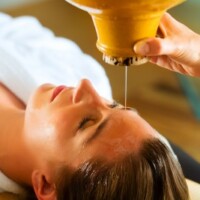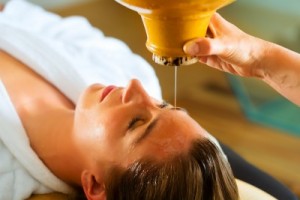





 When I first heard about how shirodhara can induce maximum relaxation when I was just a budding Ayurvedic student, I skeptically thought to myself, “Who wouldn’t find warm oil slowly being poured onto their forehead relaxing?” But what seemed to me at the time as simply a luxurious pampering has amazed me both in its broadness in application as well as the beauty behind the mechanism of how it works.
When I first heard about how shirodhara can induce maximum relaxation when I was just a budding Ayurvedic student, I skeptically thought to myself, “Who wouldn’t find warm oil slowly being poured onto their forehead relaxing?” But what seemed to me at the time as simply a luxurious pampering has amazed me both in its broadness in application as well as the beauty behind the mechanism of how it works.
What It Is
For those who are not so familiar with shirodhara, it is a therapy wherein a liquid substance, usually a warm oil or herbal oil, is slowly and steadily poured onto the third eye and then allowed to percolate through the hair. The name itself comes from the Sanskrit words shiro (head) and dhara (flow).
Shirodhara falls into the category of snehana of the shodhana (purifying) therapies in Ayurveda. While snehana means the application of oil, sneha means love and compassion. As such, oil has been glorified in the scriptures for providing the qualities of nurturing and nourishment.1 When the skin absorbs the oil, it also takes in these qualities into the body.
One of the great beauties of shirodhara lies in the fact that the forehead and scalp, of all parts of the body, has greater absorption than any other part of the body, aside from the pubic areas. 2 The skin absorbs many substances, including oil, as well as any herb that may be infused into the oil, such that they directly pass through the epidermis and dermis, into the blood stream and tissues that lie beneath. Since the brain and the main sense organs are in such close proximity to the scalp, shirodhara has its greatest and most direct effects there. For this reason, great care is taken to ensure that the highest type and quality of herbs and oils are used in the therapy.
Why It Works
Marmani. A marma is a “vital energy point on the surface of the body.” 3 The oil first pours directly onto ajna marma. Synonymous with the third eye, this marma is central to all brain function, hormone glands, and above all, consciousness. The oil then spreads over a number of other marmani. By doing so, we are powering these energetic hot spots with vata and pitta calming qualities through the qualities of the oil and therapy, itself. The qualities access the mano vaha srotas, the channel for the mind and senses, directly through the marmas, sending the same soothing and nurturing qualities throughout the channels. 3
Sensory Nerves. Not only is the head and face one of the greatest areas of absorption, but they also have the greatest number of sensory nerves. In fact, over half of the sensory cortex in the brain is dedicated to just the face and the head! There are a variety of sensory nerves- some that sense position, some sense temperature and pain, some sense pressure. The interesting connection here is that the pain and temperature nerves, specifically, course through the brain not only to the cortex, but also to the limbic portions of the brain, which are centers for processing emotions and managing conflict, motivation, learning, and attention, amongst other important functions. 4 Thus, by stimulating these nerves with anti-vata and anti-pitta qualities, we are bringing those same qualities to the limbic centers of the brain, unfolding a sense of ease and peace to an often disturbed part of our consciousness.
Further, through the somato-autonomic reflex, simply the soft and spreading touch of shirodhara and the subtle vibration throughout the cranial cavity sends an inhibitory signal to the sympathetic nervous system. 5 This results in a decrease in heart rate, respiratory rate, blood pressure, and induces an overall sense of calmness and rest. 6,7,8 It is no wonder, then, that many clients fall into deep sleep during shirodhara.
A small randomized-controlled study done in Japan studied the above mechanisms amongst others, and proposed the mechanism shown in Figure 1. As demonstrated, numerous pathways have been found, all centering around calming the sympathetic nervous system and balancing the neurochemistry in the brain. 6 In plain Ayurvedic language, the therapy calms vata and pitta rooted in mano and majja vaha srotas, thereby affecting the same doshic imbalances in other srotamsi.
Figure 1. Kazuo U, et al. Psychoneuroimmunologic Effects of Ayurvedic Oil-Dripping Treatment. The Journal of Alternative and Complementary Medicine.
Shirodhara is the king of Ayurvedic therapies for the mind and is a wonderful complement to herbs for achieving optimum mental balance and peace. Watch for our next newsletter with herbal recommendations for supporting the mind.
As an Obstetrician and Gynecologist, Vrinda Devani, M.D. has a passion for women’s health and empowering women towards vibrant health and living. She is a believer in unfolding the human body’s potential through a blend of complementary and allopathic medicine. She has studied Ayurveda extensively under Dr. Vasant Lad and furthered her studies in Ayurvedic women’s health with travels in Nepal with Dr. Sarita Shrestha. In addition to being a physician and certified Ayurvedic practitioner, she also has a love for yoga and is a certified AyurYoga teacher.
Get every new post delivered to your Inbox
Join other followers
Leave a Reply